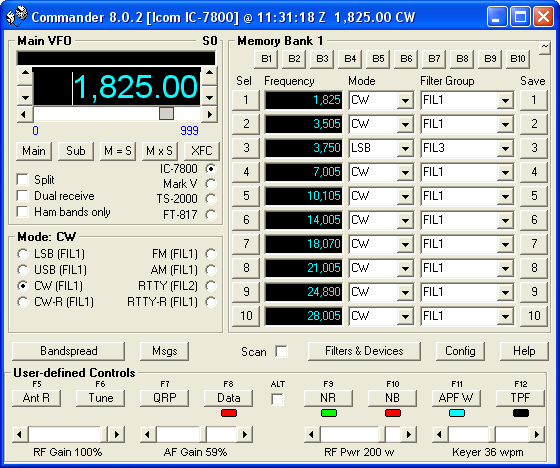Using Commander's Memories
Commander provides 10 memory banks. Each memory bank contains 10 memories. Each memory specifies
- a frequency
- a mode
- a filter group (not available for all radio models)
- notes
Viewing Memories
The Memories panel is displayed on the right side of Commander's Main window; it is labeled with the title of the currently-selected Memory Bank. If this panel is not visible, click the Memory Banks button.
The Memories panel displays 10 Memory Bank selection buttons labeled B1 through B10 across the top. The frequency, mode, and receiver bandwidth contained in each of the currently-selected Memory Bank's 10 memories are displayed below the Memory Bank selection buttons, one memory per row. To view each memory's notes, click the ~ button in the upper-right corner of the Memories panel; click the ~ button again to return to a view of each memories frequency, mode, and receiver bandwidth contents.

Selecting a Memory Bank
To select a Memory Bank, click its Memory Bank selection button; the contents of the selection bank's 10 memories will be displayed below. To view a Memory Bank's title, allow the mouse cursor to hover over its selection button for a second or two; a popup bearing the title will appear.
Setting the transceiver frequency, mode, and receiver bandwidth from a memory
Clicking a memory's Sel button sets the transceiver's frequency, mode and receiver bandwidth from the values contained in the memory contents.
Setting a memory's transceiver frequency, mode, and receiver bandwidth from the current transceiver settings
Clicking a memory's Save button sets memory's frequency, mode and receiver bandwidth from the current transceiver settings.
Clearing Memories
Clicking a memory's Save button while depressing the CTRL key clears that memory's frequency, mode, and transceiver bandwidth. Clicking the Clear Memories button on the Configuration window's Memories tab clears all memories in the currently-selected memory bank.
Directly Modifying a Memory
You can directly edit a memory's frequency and notes by typing characters into textbox that contains them. You can select a different mode or receiver bandwidth by clicking the respective selector's downward-facing arrow and choosing the desired value from the dropdown list.
Titling Memory Banks
Clicking a Memory Bank selection button while depressing the CTRL key displays the Configuration window's Memories tab, which enables you to specify the title of each Memory Bank.
Saving and Restoring Memories To and From a File
Clicking the Export Memories button on the Configuration window's Memories tab prompts you to select a file into which the contents of all memories (in all Memory Banks) will be saved.
Clicking the Import Memories button on the Configuration window's Memories tab prompts you to select a file whose contents will be loaded into Commander's Memory Banks, overwriting their current contents.
Scanning Memories
To continuously scan valid memories in the current bank, check the Scan box on the Main window. With memory scanning enabled, Commander will sequentially activate each of the current bank's memories that contain a valid frequency and mode, skipping memories not containing a valid frequency or mode. The time between activations is defined by the Scan Dwell setting. If none of the current bank's memories are valid, Commander will uncheck the Scan box and stop scanning. While scanning, the following actions will uncheck the Scan box and stop scanning:
clicking in the Bandspread window's frequency dial
double-clicking the Bandspread window's SpotCollector Alert indicator
- receipt of a QSY directive from another application
